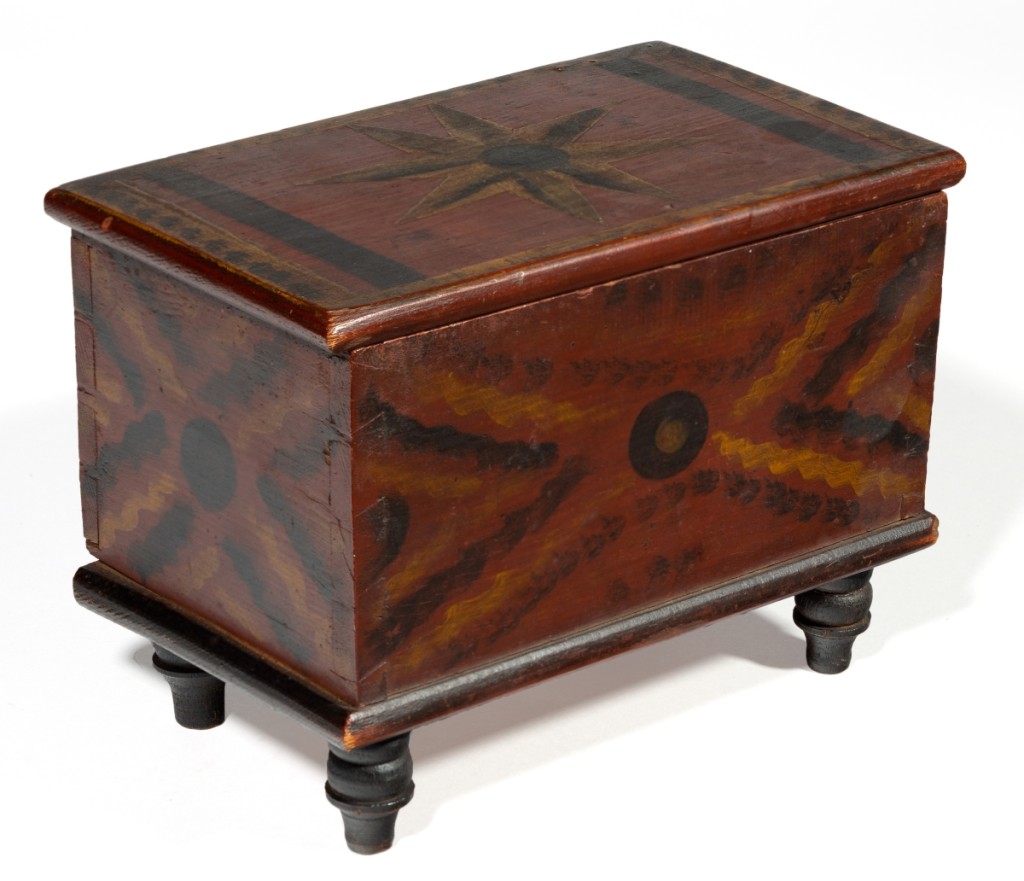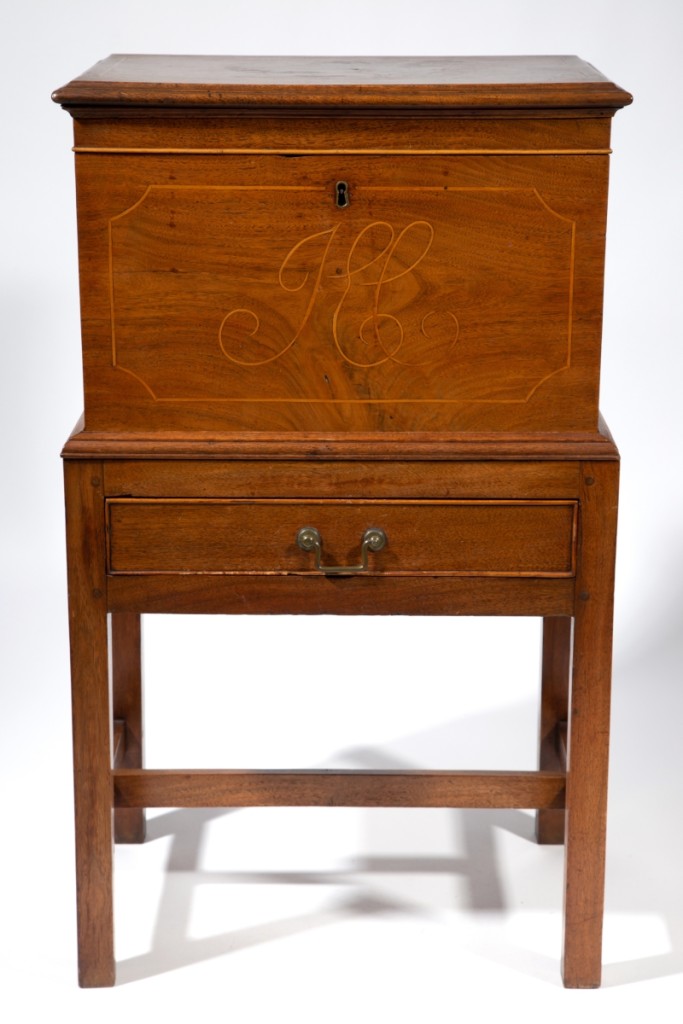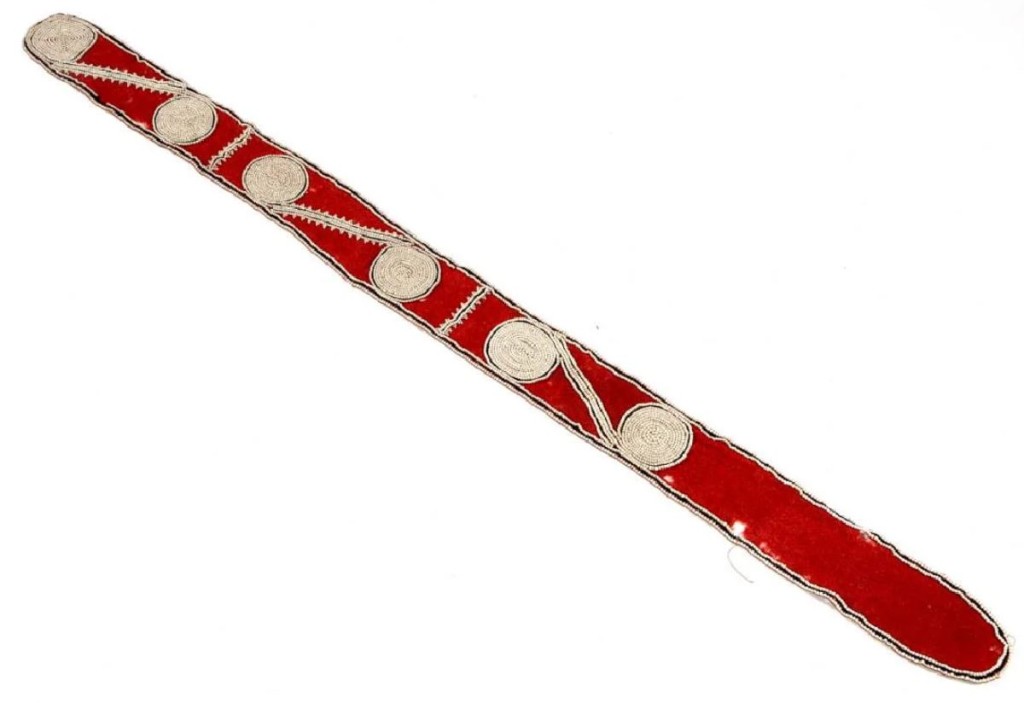Review by W.A. Demers, Photos Courtesy Jeffrey S. Evans & Associates
MOUNT CRAWFORD, VA. – Jeffrey S. Evans & Associates presented its 36th semiannual Americana and antiques auction on June 21-22. The firm said it was a highly successful event, which produced robust prices – along with a few surprises – in multiple categories. Over the two days, a total of 1,448 lots of high-quality material, much of it fresh-to-the-market, crossed the block. In several instances, material on offer had descended directly in the families of the original owners. Bidding was intense throughout each day, with thousands of registered bidders from numerous countries participating online in competition with a standing-room-only gallery crowd eager to acquire something rare and desirable. The two-day event featured historic property from estates and collections in Virginia, Georgia, Pennsylvania, Ohio, Maryland, Kentucky, Illinois and Wisconsin, including important objects from “Woodlands,” the Clopper-Hutton family home in Montgomery Co., Md.; plus several museum deaccessions, including Colonial Williamsburg and the Mount Vernon Ladies’ Association.
A rare North Carolina inlaid walnut cellaret attributed to Micajah Wilkes was the top lot in the sale, exceeding its $20/30,000 estimate to sell for $87,750. “It was a strong sale,” said company president and auctioneer Jeffrey S. Evans.
The late Eighteenth/early Nineteenth Century bottle case featured a hinged lid with finely molded edge over a blind-dovetailed case and an interior fitted with dividers. It has a single cockbeaded drawer and square legs joined with dovetailed H-form stretcher. The front panel bears a stylized “JEC” monogram within a cut-corner string-inlaid frame, and there is additional string inlay to lid. The piece retains likely original iron hinges, brass carrying handles and wooden toggle latch to reverse. Yellow pine secondary wood. Old refinished surface. Attributed to Micajah Wilkes (Bertie Co., NC).
Property from the Carter family of Virginia, literature states that the identity of the individual signified by the “JEC” monogram on the front panel remains unknown. It is likely that the “JEC” monogram combines the husband’s and the wife’s initials into an integrated whole, and while no Carter family ancestral couple is a clear candidate, family lineage records do note the marriage of a John Cooke and Elizabeth Travers in the Eighteenth Century; unfortunately, neither has been located through research.
Session I on Friday was devoted exclusively to the collection of Jack and Tommie Marsh of Columbia, S.C. There were more than 500 lots of country Americana, ship’s models, folk art, toys and textiles, all purchased from East Coast dealers. The collection was well-received, providing numerous buying opportunities at all price points for seasoned and new collectors. Top lot in this session was a Pennsylvania painted poplar bucket bench in old blue color. An unusual form with single offset drawer, the bench was contested by two determined bidders who chased it all the way to $4,095. Also noteworthy were a Pennsylvania painted pine Dutch cupboard at $3,042, a carved and painted Odd Fellows “Heart-in-Hand” ceremonial staff at $2,691 and a folk art hooked rug featuring a rabbit and “1915” date at $2,457.
Session II on June 22 included the firm’s usual selection of rare Virginia and other Southern material; Eighteenth and Nineteenth Century formal and country furniture; American fine and decorative arts; folk pottery; Nineteenth Century coin silver; Shenandoah Valley and other folk art; a selection of late Eighteenth/early Nineteenth Century English ceramic figures, Shenandoah Valley and other long rifles; early quilts and other textiles; Native American material and more.
Highlights included the rare North Carolina inlaid walnut cellaret attributed to Micajah Wilkes, a group of portraits from the Clopper-Hutton family of Maryland, featuring examples by Sully and Peale and a Stirewalt-attributed paint-decorated yellow pine diminutive box. Other noteworthy results from the Saturday session included a recently discovered Chickasaw beaded powder horn strap at $17,550.
“Portrait of Francis Cassatt Clopper” (1786-1868) attributed to Thomas Sully (1783-1872) more than doubled its estimate of $4/6,000 to finish at $14,040. The oil on canvas is recorded as No. 316 “Mr. Clopper” in the artist’s registry and is waist-length depiction of a seated figure in partial profile, face turned toward the viewer, wearing high white stock and green coat with large brass buttons. There was no signature located on circa 1810 painting, but bidders were obviously confident of the attribution.
Clopper was an important early Montgomery County, Md., resident. Born in Baltimore, he first found success as a merchant in Philadelphia, where he had this portrait commissioned in 1810, but moved to Montgomery County in 1812 with his new bride, Ann Jane Byrne Clopper. Here, the Cloppers established a grand home, “The Woodlands,” as well as a farm, grist mill and blanket factory, all of which remained important landmarks for more than 150 years.
A portrait of an auburn-haired young woman in high-waisted Empire-style gown attributed to John Gadsby Chapman (1808-1889) brought even more money. Bid to $15,210, “Portrait of Maria Graham Koontz” (1812-1896) pictures the young woman holding a rose in one hand, sporting drop earrings, necklace and an unusual blue draped textile around her shoulder. Again, no signature was found, although a Nineteenth Century inscribed note in the sitter’s hand attached verso reads, in part, “This portrait of Maria Graham / Koontz born in Harrisonburg Rock / ingham [County] Va, daughter of Jacob / Koontz and Maria Gilbert Gra[ham] / Painted by John G / [Chapm]an in Alexandria Va / year 1826 / Maria G. Carr, M. D. / Chicago 1882.” The portrait was acquired by the Colonial Williamsburg Foundation for inclusion in that institution’s collection of Southern portraiture.
The Koontz family were important early settlers of Rockingham County, Va., in the area known as Rocktown, today the city of Harrisonburg. Her grandfather had been a colonel in the local militia and even served in the Virginia legislature. Her mother, Maria Graham, tragically died only a month after the birth of her daughter, leaving her father, Jacob Koontz, to raise her alone.
A mid-Nineteenth Century copy of Gilbert Stuart’s Landsdowne portrait of Washington, attributed to the artist’s daughter, Jane Stuart, did not find a buyer.
Estimated $8/12,000, a paint-decorated yellow pine diminutive box met expectations, selling for $12,870. It was attributed to Jacob Stirewalt (1805-1869) and/or John N. Stirewalt (1802-1836), New Market, Va., and dated to circa 1840. The box was 5-3/8 inches by 7-1/8 inches wide and 4¼ inches deep. The hinged rectangular lid (retaining remnants of original leather hinges) was over a rectangular case of dovetailed construction, raised on four turned and ebonized feet mortised through the bottom of the case. A characteristic eight-pointed Virginia star was on the lid, and an old pencil inscription on the back read “Estate of Samuel Shuttes (?)”

Stirewalt family, Shenandoah Valley Of Virginia, paint-decorated yellow pine diminutive box fetched $12,870.
Bringing the same price as the miniature box was one of the earliest official printed plans depicting what would become the nation’s capitol, the city of Washington, DC, by Andrew Ellicott (1754-1820), an engraving on laid paper, engraved by Thackara & Vallance in Philadelphia, which came from the property descended in the Clopper-Hutton family, and a Virginia carved walnut tall-case clock with eight-day brass works, attributed to Benjamin Chandlee (1780-1822) likely made in the shop of his father, Goldsmith Chandlee (1751-1821) in the fourth quarter of the Eighteenth Century or early Nineteenth Century.
Militaria and folk art were also notable in this sale, with a Confederate Sharps-style 52-caliber carbine with “Richmond Va” at rear of barrel, going out at $8,775 and a Civil War-era Virginia militia two-piece belt buckle on an original belt, cinching $7,605.
Historic property descended in the Clopper-Hutton family, the belt has a poignant backstory described in the catalog notes. It was originally owned by Private William D. Scott (1843-1864), Company D, 14th Virginia Calvary, Greenbrier County, Va., (now West Virginia). When Scott was found wounded on the Clopper family’s porch at The Woodlands in 1864, he asked, “Can I die on your porch?” Private Scott and the 14th Virginia Cavalry were part of General Jubal Early’s raid on Washington, DC, in 1864. Scott was a member of a six-man scouting party who, on the evening of Sunday, July 10, stopped by the home of Joseph A. Taney asking for food. As they took dinner, they were fired upon by a Union cavalry unit. Private Scott mounted his horse in the Taney barn, but he was shot in the side by one of the Union soldiers.
Despite his wound, he still managed to ride into the woods across Seneca Creek, eluding his Union pursuers. He found his way to The Woodlands, home of Francis Clopper and his family, where a black servant reported his presence to the family. The Cloppers were Unionists, but their daughters took pity on the dying boy and took him in. They located a Confederate surgeon who removed the bullet, but despite this effort, Scott died shortly thereafter. Since it was illegal and dangerous to harbor enemy troops, the Cloppers buried Scott in secret at night in an unmarked grave under the hedge in front of the nearby Saint Rose of Lima Catholic church. The Daughter’s of the Confederacy erected a stone marking his grave in the 1930s.
Two Civil War-era dolls that had been handmade by slaves on a plantation in Beaufort County, N.C., were reportedly made before the Civil War as surprise gifts for the children of Emily Baker Lucas Smallwood (1837-1905). When Union gunboats came up the Tar River, the family gathered belongings, and the children brought along these dolls during their evacuation, At auction, the pair brought $8,775.
Several institutional deaccessions were also featured in Session II, including an assortment of Eighteenth and Nineteenth Century English Staffordshire ceramic figures from the Colonial Williamsburg Foundation and select textiles from the Mount Vernon Ladies’ Association, Mount Vernon, Va.
One of the many surprises throughout the day involved an Eighteenth Century English Staffordshire Whieldon-type 7¾-inch-high figure of an owl, which was bid to $7,020.
After the sale, Evans commented, “We were very pleased with the strong interest across the board in this auction. The gallery was packed for Session II on Saturday, resulting in a level of robust, sustained bidding that produced very strong results across all categories of the sale. A key part of that success was the estate-fresh nature of much of the material offered. It was an honor to work with the Clopper family estate and the Chrisman collection, for instance, and we certainly hope to continue to attract more like consignments as they come to market.” Evans added, “Our multi-session November 2019 Americana auction will feature several important collections of early American glass, highlighted by an important Pittsburgh cut-glass mantel ornament bearing a sulphide bust of George Washington, an exceptional Stirewalt family paint-decorated chest and an important collection of American needlework, so we are looking forward to another exciting sale.”
Prices given include the buyer’s premium, as stated by the auction house. For information, www.jeffreysevans.com or 540-434-3939.



















